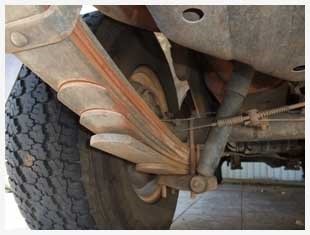Pre-Trip Inspection Checks
Published by Peter Harris on 22nd Feb 2017
Heading out bush, driving through the outback or even hitting your local off-road trails is an exhilarating experience! In order to safely experience the vast outdoors, it is crucial to prepare and monitor your vehicle for obvious signs of wear and tear in an attempt to be as self-sufficient as possible. Following are a few things you can do to make sure your next adventure is safe and filled with tons of fun!
Checking your Battery - Age and Health
 Car batteries play an integral role in your vehicle. From something as basic and easy as unlocking the doors of the vehicle in the morning to actually turning your vehicle’s engine in order to provide ignition. All vehicle electronics, including car stereo, driving lights etc. are also run by the battery. Keeping this in mind, it is essential to have a healthy battery before you start any trip, whether short or long. On a normal day, a fully charged battery should spit out around 12.6v – 12.7v of charge. This level of charge shows decent health of the battery. Anything lower than this would indicate an ageing or an unhealthy battery. Normally speaking, car batteries should be changed every two years, depending on your usage and load on the battery.
Car batteries play an integral role in your vehicle. From something as basic and easy as unlocking the doors of the vehicle in the morning to actually turning your vehicle’s engine in order to provide ignition. All vehicle electronics, including car stereo, driving lights etc. are also run by the battery. Keeping this in mind, it is essential to have a healthy battery before you start any trip, whether short or long. On a normal day, a fully charged battery should spit out around 12.6v – 12.7v of charge. This level of charge shows decent health of the battery. Anything lower than this would indicate an ageing or an unhealthy battery. Normally speaking, car batteries should be changed every two years, depending on your usage and load on the battery.
Spare Tyres
 Goes without saying, at least one spare tyre for your vehicle is an absolute must. Depending on how remote you plan on traveling, this number could increase to two or even three spare tyres (if not more) in some cases. Having a flat tyre without any spares would grind you to a halt, completely stranded. While it is important to carry spare tyres, it is also essential to actually check the tyre pressure of these spares as well. No, it’s not fun to get a tyre punctured and reach out for your spare, only to realise that the spare is flat as well!
Goes without saying, at least one spare tyre for your vehicle is an absolute must. Depending on how remote you plan on traveling, this number could increase to two or even three spare tyres (if not more) in some cases. Having a flat tyre without any spares would grind you to a halt, completely stranded. While it is important to carry spare tyres, it is also essential to actually check the tyre pressure of these spares as well. No, it’s not fun to get a tyre punctured and reach out for your spare, only to realise that the spare is flat as well!
Underbody Inspection
 Get under your vehicle, and inspect it! Doing so will enable you to know of any oil leaks that may have developed over time and give you a chance to give attention to these oil leaks before they actually start damaging your vehicle components. Look for oil leaks from your front/rear differentials, gear box and engine oil sump. While you’re down there, also inspect all the moving components. This would include things like the drive shafts, propeller shafts and suspensions. Doing so will enable you to pick up on any obvious damage or signs of wear and tear that may require urgent attention.
Get under your vehicle, and inspect it! Doing so will enable you to know of any oil leaks that may have developed over time and give you a chance to give attention to these oil leaks before they actually start damaging your vehicle components. Look for oil leaks from your front/rear differentials, gear box and engine oil sump. While you’re down there, also inspect all the moving components. This would include things like the drive shafts, propeller shafts and suspensions. Doing so will enable you to pick up on any obvious damage or signs of wear and tear that may require urgent attention.
Carrying Spares
By doing the above mentioned steps, you will get an estimated idea of what spares you may need to carry with you. Some components may not be bad enough to be replaced, but may need replacement in the coming future. This way, anything you find suspicious during vehicle inspections that does not need urgent attention, can be added to your spares list.
Toolbox and Recovery Equipment
 This would be one of the most important things in your trunk. No matter how many spares you carry, or how much replaceable oil you have, it will be of no use unless you have decent toolbox with you. Carrying a good tool box will enable you to either change out complete parts if they break or even do small repairs if required.
This would be one of the most important things in your trunk. No matter how many spares you carry, or how much replaceable oil you have, it will be of no use unless you have decent toolbox with you. Carrying a good tool box will enable you to either change out complete parts if they break or even do small repairs if required.
It is also essential on carrying recovery equipment based on the kind of travelling you’re doing. If you’re headed off-road, then a complete recovery kit is almost necessary to be carried along! Side note – Carry heaps of zip – ties, you’ll thank your good stars later!
Vehicle Service
Keep a note of when your vehicle was last serviced. It is recommended to service a diesel vehicle every 5,000kms and a petrol vehicle every 10,000kms. This number would fluctuate up or down depending on your usage and kind of driving you do. Having a well serviced vehicle will not only ensure good health of your engine but also give you better fuel economy (save you a few dollars!!).
Giving your vehicle a thorough look prior to your departure will enable your vehicle to be in good health while on your journey and also help you decide what to bring along and what to leave at home!
Now click those belts in and have a blast out there!
- Sujay Vasist - All Four x 4 Spares Researcher & Content Writer
Image Sources
http://www.wisegeek.org
http://rijidijoffroad.bounce.com.au
http://www.outbackcrossing.com.au
http://www.clarketooling.co.uk

